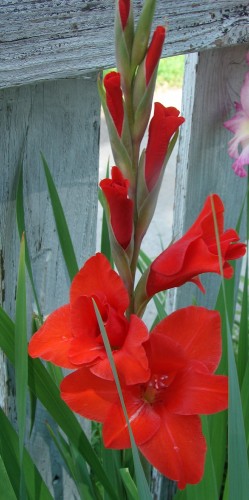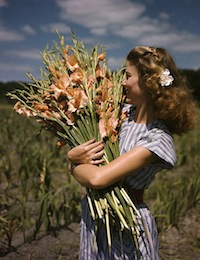- Geraniums: Two Floral Families with Striking Flowers - December 15, 2019
- Festive Flowers for a Dazzling Winter Bouquet or Centerpiece - December 14, 2019
- Forcing Flower Bulbs For the Holiday Season - December 13, 2019
The gladiolus flower is best known for its tall spikes of ruffled blooms. These stems can reach two to four feet in length with blossoms blooming in succession from the bottom up. Gladioli are a member of the Iris family and originated in Africa and the Mediterranean several thousand years ago.
The name gladiolus is derived from the Latin word for sword. This refers to the long pointed leaves the plant exhibits. Dating back to the Roman era, the association with the sword led to the gladioli representing moral integrity. The sword analogy was carried on further as gladioli have been said to pierce the heart of their recipient with the sender’s passions.
Hybridization of gladioli began in the early 1800s. There are now several thousand varieties with colors ranging from delicate pastels to brilliant jewel tones. Bi-color flowers have also become popular in gardens and bouquets. These colorful blooms send a message of admiration and affection to the recipient.
White gladiolus flowers are often used in sympathy and funeral arrangements. They symbolize remembrance and purity of spirit. A bouquet of white gladioli makes a stunning statement of honor and respect.
When planted in gardens, gladioli are frequently positioned near walls or fences. This allows the tall heavy blooms to be supported as they grow. Because gladiolus stalks bloom gradually, from the bottom up, they are long-lasting once cut. With proper care, they can remain fresh for nearly two weeks, making them well-suited for gift giving.
Gladiolus flowers are the traditional birth flower for the month of August. They are appropriate for all types of celebrations, especially August birthdays. They are also given in honor of the fortieth wedding anniversary.
Various uses of gladiolus roots, or corms, have been recorded throughout the centuries. Some believe they assist with digestive regularity, or with helping to remove thorns. Caution is urged, as many varieties of gladioli are toxic. In fact, only the Gladiolus dalenii is known to be eaten in great quantities, in today’s Congo.
Gottfried Benn, a German medic during WWI, was so inspired by gladioli that he wrote a poem about them. He refers to the stately blooms as “highly emblematic of creation” and “sure of kingly dreams”.
The statuesque gladiolus flower has been inspiring powerful emotions for millenia. Send a loved one a gift of gladioli and tell them how they inspire the emotion in you.




